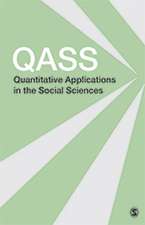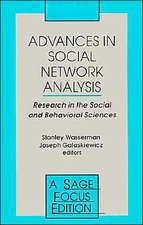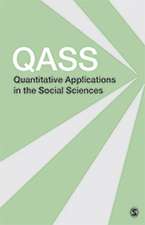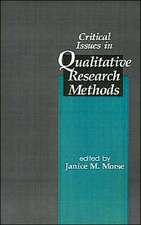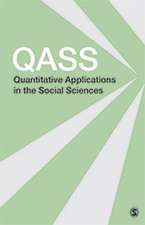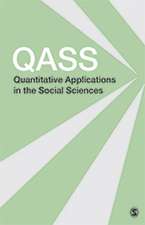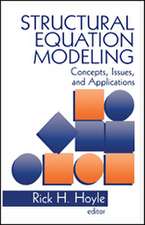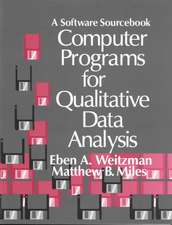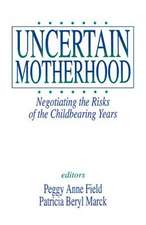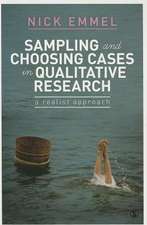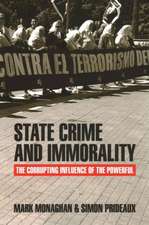Doing Realist Research
Editat de Nick Emmel, Joanne Greenhalgh, Ana Manzano, Mark Monaghan, Sonia Dalkinen Limba Engleză Paperback – 5 iul 2018
Not just an overview of the field, this book looks to extend current debates and apply realist methods to new and practical challenges in social research. Featuring practical, worked examples of how to turn theory into evidence, it empowers readers not just to understand realist methods, but to use them.
It will help readers:
- Negotiate the complexity of relational systems
- Understand the importance and relevance of cumulative theory
- Address concerns over data sources and quality
- Be flexible and creative in realist approaches
- Produce useful evidence for policy.
Sophisticated and globally minded, this book is the perfect addition to the ongoing development and application of realist methods across evaluation, synthesis, and social research.
| Toate formatele și edițiile | Preț | Express |
|---|---|---|
| Paperback (1) | 359.91 lei 3-5 săpt. | +27.17 lei 7-13 zile |
| SAGE Publications – 5 iul 2018 | 359.91 lei 3-5 săpt. | +27.17 lei 7-13 zile |
| Hardback (1) | 934.99 lei 6-8 săpt. | |
| SAGE Publications – 5 iul 2018 | 934.99 lei 6-8 săpt. |
Preț: 359.91 lei
Nou
Puncte Express: 540
Preț estimativ în valută:
68.87€ • 75.04$ • 58.03£
68.87€ • 75.04$ • 58.03£
Carte disponibilă
Livrare economică 02-16 aprilie
Livrare express 19-25 martie pentru 37.16 lei
Preluare comenzi: 021 569.72.76
Specificații
ISBN-13: 9781473977891
ISBN-10: 1473977894
Pagini: 272
Dimensiuni: 170 x 242 x 18 mm
Greutate: 0.5 kg
Ediția:1
Editura: SAGE Publications
Colecția Sage Publications Ltd
Locul publicării:London, United Kingdom
ISBN-10: 1473977894
Pagini: 272
Dimensiuni: 170 x 242 x 18 mm
Greutate: 0.5 kg
Ediția:1
Editura: SAGE Publications
Colecția Sage Publications Ltd
Locul publicării:London, United Kingdom
Recenzii
This is the book the realist community has been asking for. It offers "tricks of the realist trade", with useful tips for realist researchers and evaluators in areas from eliciting program theory and data gathering to understanding mechanisms. Reading the book is like eavesdropping on leaders in the field as they discuss each others’ work, and indicate future directions for realist approaches.
This book is a feast to read and work with. With hands-on advice about realist methods, utilization and fieldwork as well as in-depth discussions around mechanisms, theories, and epistemology, it deserves a very warm welcome from realist and social researchers alike.
I wish all social science researchers would read this book – and then think much more carefully about the way they design and enact research studies. It sets out clearly the ideas of realistic or theory-driven evaluation, and brings together great wisdom and experience in doing such evaluations in practice.
This book successfully combines cutting-edge accounts of the application of realist research with important discussions about its scope. Its appeal is enhanced by the inclusion of significant reflections on the development and current state of play of realist enquiry.
This book offers stimulating analyses of the development and application of a realist approach to evaluation, evidence synthesis, and empirical research generally. With illustrations from projects in which they have been involved, the authors illuminate key methodological topics, from the nature of causal mechanisms to the task of "impacting" on policymaking. Anyone with an interest in this approach, and especially in putting it into practice, will find the book essential reading.
This important book provides detailed, practical advice on using realist theories and methods in program evaluation and social research. In particular, it is pathbreaking in demonstrating the value of integrating qualitative and quantitative approaches in realist research.
Doing Realist Research combines the foundations of the realist methodology with the very latest thinking in the application, and development, of the approach. From understanding mechanisms, and the formulation of programme theories, to understanding the role of complexity, and conducting economic evaluations. This engaging, easy to read book provides comprehensive advice and guidance for novices and experts alike.
The clear explanations of Programme Theories, Contexts and Mechanisms enable the novice realist researcher to understand the methodology and design their study effectively. There were a number of helpful hints presented, such as the online PubVenn tool that graphically represents the fruits of a literature search.
This is a must-have text-book for researchers undertaking a Realist Synthesis or a Realist Evaluation study, particularly masters and doctoral students
In using this book to inform my own research, in both public health and education, it was debates around the conceptualization of mechanisms (a central tenet in realist research), and the role of mechanisms within complex interventions and complex social environments which most captured my interest. These early chapters embody Campbell’s (1998) ‘disputative body of scholars’ as the widely accepted definition of mechanism is challenged, debated, and adapted to meet the needs of the research presented
This book is a feast to read and work with. With hands-on advice about realist methods, utilization and fieldwork as well as in-depth discussions around mechanisms, theories, and epistemology, it deserves a very warm welcome from realist and social researchers alike.
I wish all social science researchers would read this book – and then think much more carefully about the way they design and enact research studies. It sets out clearly the ideas of realistic or theory-driven evaluation, and brings together great wisdom and experience in doing such evaluations in practice.
This book successfully combines cutting-edge accounts of the application of realist research with important discussions about its scope. Its appeal is enhanced by the inclusion of significant reflections on the development and current state of play of realist enquiry.
This book offers stimulating analyses of the development and application of a realist approach to evaluation, evidence synthesis, and empirical research generally. With illustrations from projects in which they have been involved, the authors illuminate key methodological topics, from the nature of causal mechanisms to the task of "impacting" on policymaking. Anyone with an interest in this approach, and especially in putting it into practice, will find the book essential reading.
This important book provides detailed, practical advice on using realist theories and methods in program evaluation and social research. In particular, it is pathbreaking in demonstrating the value of integrating qualitative and quantitative approaches in realist research.
Doing Realist Research combines the foundations of the realist methodology with the very latest thinking in the application, and development, of the approach. From understanding mechanisms, and the formulation of programme theories, to understanding the role of complexity, and conducting economic evaluations. This engaging, easy to read book provides comprehensive advice and guidance for novices and experts alike.
The clear explanations of Programme Theories, Contexts and Mechanisms enable the novice realist researcher to understand the methodology and design their study effectively. There were a number of helpful hints presented, such as the online PubVenn tool that graphically represents the fruits of a literature search.
This is a must-have text-book for researchers undertaking a Realist Synthesis or a Realist Evaluation study, particularly masters and doctoral students
In using this book to inform my own research, in both public health and education, it was debates around the conceptualization of mechanisms (a central tenet in realist research), and the role of mechanisms within complex interventions and complex social environments which most captured my interest. These early chapters embody Campbell’s (1998) ‘disputative body of scholars’ as the widely accepted definition of mechanism is challenged, debated, and adapted to meet the needs of the research presented
Cuprins
Introduction: Doing realist evaluation, synthesis and research - Nick Emmel, Joanne Greenhalgh, Ana Manzano, Mark Monaghan, and Sonia Dalkin
Chapter 1: The middle range methodology of realist evaluation - Nick Tilley
Chapter 2: Making up mechanisms in realist research - Malcolm Williams
Realists need mechanisms, so what are they?
The epistemology and ontology of mechanisms
Measurement and evidence
Some mechanisms
Chapter 3: Understanding mechanisms in realist evaluation and research - Gill Westhorp
Constructs of mechanism
Mechanisms in evaluation
Open systems
Alternate constructs of mechanism
Powers and liabilities
Interactions
Processes
Reasoning and resources
Multiple constructs of mechanism
Mechanisms and the context-mechanism relationship
Chapter 4: Making claims using realist methods - Brad Astbury
Historical context
Conducting realist evaluation: an illustration
The set-up
Enter middle-range theory
Tricks of the realist trade
Chapter 5: Theory and realist methods - Bruno Marchal, Guy Kegels and Sara Van Belle
Using realist evaluation in HPSR in low-resource settings
With which theory to start?
How to elicit the initial programme theory
Chapter 6: Researching complex large scale nested interventions - David Byrne
Large scale interventions
Defining boundaries
Traces of the conditions of a system
Chapter 7: Using realist approaches to explain the costs and cost-effectiveness of programmes - Rob Anderson, Rebecca Hardwick, Mark Pearson, and Richard Byng
What are realist evaluations?
What are economic evaluations?
How are they different from realist evaluation?
Measurement vs explanation/theory-building
Creating localised vs generalizable knowledge
What would more explanatory economic evaluation look like?
Programme theories of cost-effectiveness – a worked example
Refining the theories of cost-effectiveness
Chapter 8: Data gathering for realist reviews - Geoff Wong
Gathering data
Relevant data
Programme theory
Rigour, data ‘quality’ and more...
Chapter 9: Scoping and searching to support realist approaches - Andrew Booth, Judy Wright and Simon Briscoe
The "realist search" and synthesis
Complementary searching techniques
The role of the information specialist in supporting realist approaches
Elements of a “realist search”
Sources of programme theories
Chapter 10: Evidence from realist research, its influence and impact - Mark Monaghan and Annette Boaz
Impact debates
The emergence of the systematic review
Considering the emergence and reach of realist review
Some provisional lessons from and for realist review
Analysing impact
Chapter 11: Realist research, guidelines and the politics of evidence - Mike Kelly
EBM, clinical medicine and public health
Epistemic shifts
Developing the evidence base and guidelines in public health in practice
Guideline development
Realism and EBM meet realpolitik
Chapter 12: Realist memorabilia - Ray Pawson
The test of time
CMO revisited
Utilisation
Chapter 1: The middle range methodology of realist evaluation - Nick Tilley
Chapter 2: Making up mechanisms in realist research - Malcolm Williams
Realists need mechanisms, so what are they?
The epistemology and ontology of mechanisms
Measurement and evidence
Some mechanisms
Chapter 3: Understanding mechanisms in realist evaluation and research - Gill Westhorp
Constructs of mechanism
Mechanisms in evaluation
Open systems
Alternate constructs of mechanism
Powers and liabilities
Interactions
Processes
Reasoning and resources
Multiple constructs of mechanism
Mechanisms and the context-mechanism relationship
Chapter 4: Making claims using realist methods - Brad Astbury
Historical context
Conducting realist evaluation: an illustration
The set-up
Enter middle-range theory
Tricks of the realist trade
Chapter 5: Theory and realist methods - Bruno Marchal, Guy Kegels and Sara Van Belle
Using realist evaluation in HPSR in low-resource settings
With which theory to start?
How to elicit the initial programme theory
Chapter 6: Researching complex large scale nested interventions - David Byrne
Large scale interventions
Defining boundaries
Traces of the conditions of a system
Chapter 7: Using realist approaches to explain the costs and cost-effectiveness of programmes - Rob Anderson, Rebecca Hardwick, Mark Pearson, and Richard Byng
What are realist evaluations?
What are economic evaluations?
How are they different from realist evaluation?
Measurement vs explanation/theory-building
Creating localised vs generalizable knowledge
What would more explanatory economic evaluation look like?
Programme theories of cost-effectiveness – a worked example
Refining the theories of cost-effectiveness
Chapter 8: Data gathering for realist reviews - Geoff Wong
Gathering data
Relevant data
Programme theory
Rigour, data ‘quality’ and more...
Chapter 9: Scoping and searching to support realist approaches - Andrew Booth, Judy Wright and Simon Briscoe
The "realist search" and synthesis
Complementary searching techniques
The role of the information specialist in supporting realist approaches
Elements of a “realist search”
Sources of programme theories
Chapter 10: Evidence from realist research, its influence and impact - Mark Monaghan and Annette Boaz
Impact debates
The emergence of the systematic review
Considering the emergence and reach of realist review
Some provisional lessons from and for realist review
Analysing impact
Chapter 11: Realist research, guidelines and the politics of evidence - Mike Kelly
EBM, clinical medicine and public health
Epistemic shifts
Developing the evidence base and guidelines in public health in practice
Guideline development
Realism and EBM meet realpolitik
Chapter 12: Realist memorabilia - Ray Pawson
The test of time
CMO revisited
Utilisation
Descriere
Bringing together leading theorists, researchers and policy makers with expertise in using realist methods, this book is a definitive guide to putting realist methodologies into practice.

